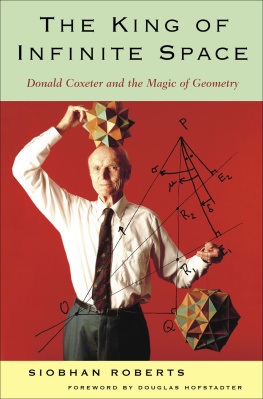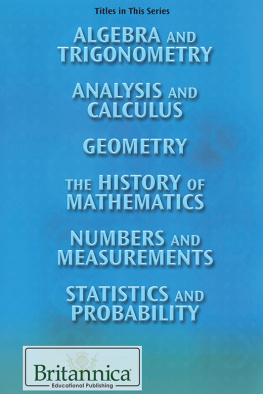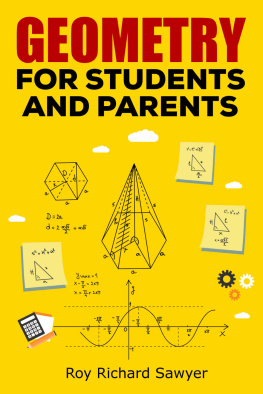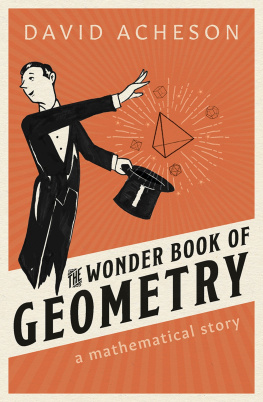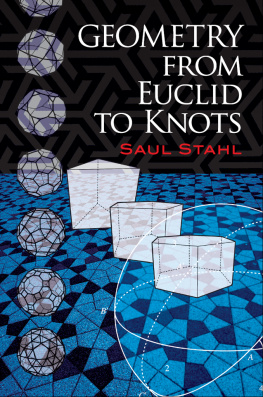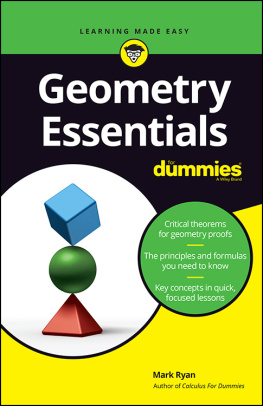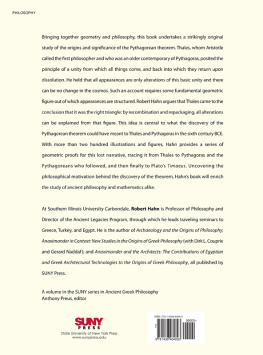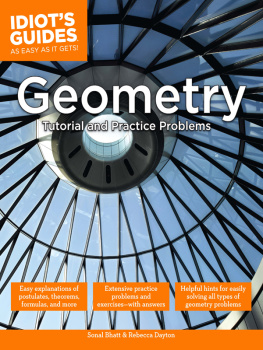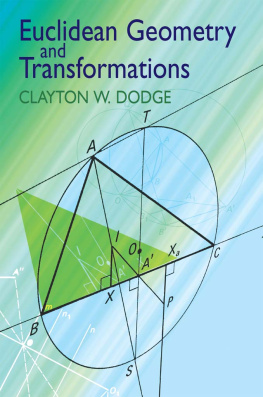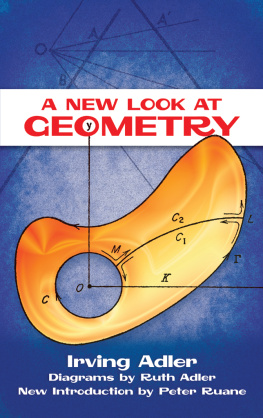KING OF
INFINITE SPACE
KING OF
INFINITE SPACE
Donald Coxeter, the Man Who Saved Geometry
SIOBHAN ROBERTS

Copyright 2006 by Siobhan Roberts
All rights reserved. No part of this book may be used or reproduced in any manner whatsoever without written permission from the publisher except in the case of brief quotations embodied in critical articles or reviews. For information address Walker & Company, 104 Fifth Avenue, New York, New York 10011.
Published by Walker Publishing Company, Inc., New York
Distributed to the trade by Holtzbrinck Publishers
All papers used by Walker & Company are natural, recyclable products made from wood grown in well-managed forests. The manufacturing processes conform to the environmental regulations of the country of origin.
Library of Congress Cataloging-in-Publication Data has been applied for.
eISBN: 978-0-802-71832-7
Visit Walker & Company's Web site at www.walkerbooks.com
First U.S. edition 2006
1 3 5 7 9 1 0 8 6 4 2
Typeset by Westchester Book Group
Printed in the United States of America by Quebecor World Fairfield
FOR MY MOM, ANNE,
an elegant wordsmith,
AND DYLAN,
as consummate a questioner as Kipling
I could be bounded in a nutshell and count
myself a king of infinite space.
- WILLI AM SHAKESPEARE, HAMLET, ACT II, SCENE 2
(AS CITED BY COXETER REGARDING
" THE FINITENESS OF TRIANGLES,"
INTRODUCTION TO GEOMETRY)
CONTENTS
DOUGLAS R. HOFSTADTER
CENTER FOR RESEARCH ON CONCEPTS AND COGNITION
INDIANA UNIVERSITY
It is a great honor to have my name linked with that of Donald Coxeter.
As a mathematics and physics student in the 1960s and 1970s, I often ran across the intriguing name H. S. M. Coxeter. I knew that this man's books were world famous, had heard that they were elegant and concise, and, on flipping through them once or twice, had even seen that they were filled with beautiful, enticing diagrams. But somehow, I had other things on my mind and I paid them little heed. When, decades later, I finally came under the spell of Coxeter's words, images, and ideas, I fell in love with geometry.
What eventually launched me on a collision course with geometry was a spectacular course on complex analysis that I took at Stanford University way back in 1962. This course was given by a young professor named Gordon Latta, who hailed from Toronto, the city in which English-born Donald Coxeter eventually settled. Latta, without doubt the best mathematics teacher I ever had, was extremely visual in his teaching, and he conveyed the depth and power of calculus in the two-dimensional arena of complex numbers in an inimitable fashion. One image from that course stuck with me for three decadesthat of a circle turning the complex plane inside out, flipping the finite disk inside the perimeter into the infinite region outside the perimeter, and vice versa.
One fateful morning in 1992thirty years after Latta's courseI woke up with that image of circular inversion in my head, for God knows what reason, and in particular with the vague memory that any circle outside the disk was carried, by this strange but lovely operation, into a circle inside the disk (and vice versa). This weird geometric fact, which I knew Latta must have proven, struck me as so marvelous that I immediately decided to try to prove it myself. Actually, I wasn't entirely sure that I was remembering the statement correctly, and this made my idea of proving it a little dicier. Indeed, my first attempt, rather ironically, showed that a random circle did not become another circle! However, my sense of mathematical aesthetics insisted that this statement had the ring of truth, and compelled me to try again. The second time around, I caught my dumb mistake (the center doesn't go to the center!) and proved that circles indeed remain circles when flipped inside out by circles.
This small but joyful excursion into inversion was the tiny spark that ignited a forest fire in my brain, and over the next few months, as geometric imagery started cramming my head fuller and fuller, I knew I needed an external guide. Where else to turn but to the person whose name for me was synonymous with the word "geometry"H. S. M. Coxeter? I bought a copy of the thin volume he had written with Samuel Greitzer, called GeometryRevisited, and went through it from beginning to end, absorbing the ideas with passion. Some of them, as it happened, I had already invented on my own, but by far the majority were brand new to me and served as springboards for countless geometrical forays that I made over the next several years. Thanks to Coxeter and Greitzer, I was flawlessly launched on one of the richest and happiest explorations in my life.
Somewhere around six months into my geometrical odyssey, I used a chain of analogies to make a discovery that excited me greatly, and I wrote up the story of this discovery in a short essay. I wanted to find out if my discovery was new or old, so I decided to seek the reaction of a number of geometers whose books I admired. First and foremost was Donald Coxeter, and so I took the plunge and sent him my essay along with a cover letter. Not wishing to impose, I tried to be very brief (a mere ten pages!), but felt I at least had to tell him how much his book had meant to me. In a most cordial and prompt reply, he suggested I take a look at a couple of books he had written on projective geometry, and so, without hesitation, I purchased them both.
The older of the two was a concise opus entitled The Real ProjectivePlane, and I have to say that reading this was another dazzling revelation to me. As Coxeter points out in his preface, the restriction to the real plane in two dimensions makes it possible for every theorem to be illustrated by a diagram. And not only is this possible, but in the book it is done. By itself, this simple fact makes the book a gem. Moreover, Coxeter strictly adheres to the philosophy of proving geometric theorems using geometric methods, not using algebra. This means that a reader of The Real Projective Plane comes to understand projective geometry through the ideas that are natural to it, building up an intuition totally unlike the intuition that comes through formulas. I am not impugning what is called the analytic style of doing geometry; I am just saying that coming to understand projective geometry using the synthetic style was among the most gratifying mathematical experiences I have ever had. I will never forget the many nights I spent in bed reading Coxeter's monograph with only a tiny reading light perched on it (in fact, inside it), in order not to wake up my wife, who had nothing against my infatuation with geometry but who seemingly couldn't sleep a wink if even a single photon impinged on her eyelids.
I cannot resist quoting a sentence in the preface to The Real ProjectivePlane. It says this: "Chapter 10 introduces a revised axiom of continuity for the projective line, so simple that only eight words are needed for its enunciation." I think Donald Coxeter must have felt not only pleased but also proud as he wrote this down, because he was so in love with simplicity, elegance, and economy of means. Here is the eight-word definition to which he was referring: "Every monotonic sequence of points has a limit." What a delight! As you probably can tell, my copy of The Real Projective Plane is one of my most lovingly read and most prized possessions.
Speaking of doing geometry with a minimum of photons, I have to relate one of the most absurd and yet enriching geometrical experiences I have ever had. Somewhere in my many readings on geometry, I came across a vignette about a famous nineteenth-century German geometerprobably Steiner, Pliicker, von Staudt, or Feuerbachwho was so suspicious of the insidious dangers supposedly lurking in diagrams that he insisted on teaching his students geometry in a pitch-dark room, using words and words alone to convey all the ideas. When I first read about this, I was nonplussed, thinking it to be among the silliest notions I had ever heard of. But perhaps precisely because it was so silly, this scene kept bouncing around in my head for a long time, and eventually, years later, when I myself was teaching a course on triangle geometry that often met at my house at night, I couldn't resist pulling down all the shades, turning off all the lights, and trying out this technique myself. The room became absolutely pitch dark, so dark that the students couldn't even see my arms move when I traced geometric shapes in the air. All they ever knew about were my spoken words, not my physical gestures. And what theorem did I prove to them in that darkest darkness of night? None other than the gleaming jewel known as Morley's theorem, which states that the "taboo" trisectors of the three angles of a random triangle join each other at the corners of an equilateral triangle floating somewhere inside the random triangle. Did they see it in their mind's eyes? I am sure they did! And what proof did I relate to my assembled students? Well, naturally, it was the one I had found in the pages of Coxeter and Greitzer's little volume and had made my own, although of course I had to adapt it to fit my brave new light-free, diagram-free circumstances.
Next page
